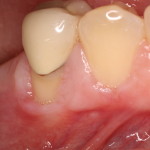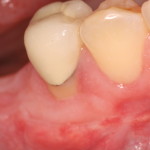Why do my gums recede & bleed?
There are several factors that can cause recession and persistent inflammation in localized areas of gingival tissue. A common factor includes lack of keratinized tissue surrounding natural teeth. Keratinized tissue is defined as the distance between the mucogingival junction and the free gingival margin. To the non-dentist, this is the non-mobile lighter pink colored tissue. Is this tissue required to maintain health and minimize the risk of inflammation? This question can only be answered on a case by case analysis. A simple answer is yes for a majority of patients, and no for a minority of patients. Anatomical factors, plaque control (home care), and previous dental treatment (i.e. crowns and/or removable partials) will determine which category you belong. Lang & Loe ’72, confirmed this theory by reporting that 100% of sites with <2mm of keratinized tissue showed clinical signs of inflammation.
The current case was referred to me for treatment by her general dentist. She presented with localized recession and inflammation. The dentist had determined that progression of the recession was severe by comparing cast models taken 5 years apart. A Free Gingival Graft was utilized to gain sufficient keratinized gum tissue and root coverage. Complete root coverage could not be obtained due to bone loss, but the substantial increase in keratinized gingiva eliminates the possibility of recession in the future. The most important factor in determining whether treatment is required is to quantify the recession at every dental appointment. This allows the clinician to determine the progression / stability of the recession. It is equally important that a clinician does not just eye ball or visualize a site for progression of recession. This tactic is anecdotal at best, and puts the patient at risk for unnecessary increase in recession.
- Continued progression of receding gums.
- Correction of receding and inflamed gums





 by
by 


